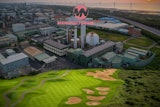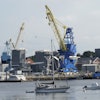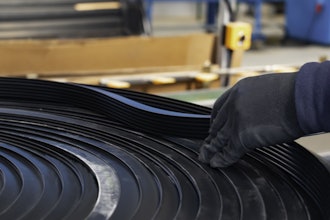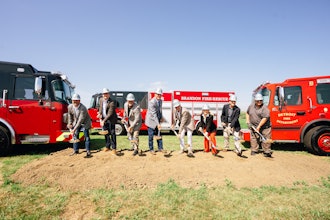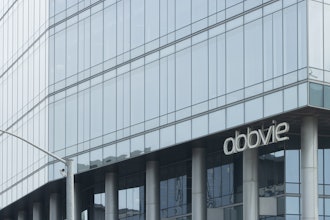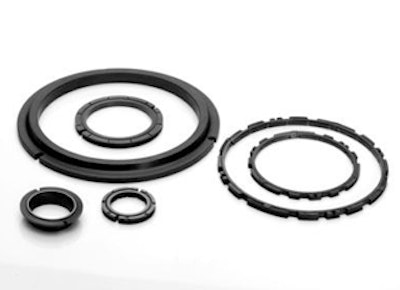
Modern mechanical carbon materials are being used in a wide variety of applications – a few examples include aircraft gear boxes, air turbine motor starters, and main shaft seals for both aircraft turbine engines and aircraft auxiliary power units (APUs).
These unique, self-lubricating materials are composed of fine-grained, electrographite substances that are impregnated with proprietary inorganic chemicals to improve their lubricating qualities and their oxidation resistance. These modern carbon-based materials are ideal for use in aircraft applications because of their low coefficient of friction, their low wear rate at high sliding speed, their high thermal conductivity, and their resistance to oxidation in high temperature air.
These properties also make the materials of interest to designers of other high speed, rotating equipment, for example high speed rotary gas compressors and steam turbines.
Mechanical carbon materials stand up to high sliding speed in shaft seals for aircraft gear boxes
Aircraft gearboxes are used to reduce the main engine shaft’s rotational speed from as high as 26,000 rpm down to about 3,400 rpm, so the shaft can drive such system components as hydraulic pumps, generators, and air conditioning compressors.
To seal the oil lubricant within the gearbox and protect it from leaking out at the point where the shaft enters and exits the gearbox, most aircraft gearboxes use face seals. The face seals usually contain a carbon-graphite stationary ring and a silicon carbide or tungsten carbide rotating ring. The rings that make the dynamic face seal are both lapped flat and are held together with springs or magnets so that liquids cannot flow between the ring faces even though they are spinning against each other at high rpm.
The two rings in relative motion that make the dynamic seal are sealed to the shaft or the gear box housing with static seal rings such as polymeric O-rings. Seal designers use spiral grooves, straight grooves, and wedges to channel or pump a thin film of air or oil between the two sliding sealing faces. This creates aerodynamic or hydrodynamic lift, which greatly reduces the friction and wear of the seal faces.
For example, Metcar Grade M-45, manufactured by Metallized Carbon Corporation, is often used successfully as the stationary ring. This material is especially suited for these shaft seals because it is impermeable and thus able to support an aerodynamic film. It also has the ability to run at high speed with low friction and low wear.
Shaft seals for air turbine motor starters must withstand extremely high shaft speed
Air turbine motor starters typically use the same carbon-graphite versus silicon carbide or tungsten carbide dynamic face seal materials that are used in gearbox seals, but the sliding speed is much higher. These air turbine motor starters are actually small turbines that use the exhaust gas from the auxiliary power unit to create the power necessary to start the main engines. The shaft speed on air motor starters can be as high as 180,000 rpm, or a sliding speed of about 1000 feet/second, which is nearly the speed of sound. The seals are designed by aircraft seal manufactures with wedges and gas flow passages to produce aerodynamic or hydrodynamic lift-off. Metcar Grade M-45 is used in air motor starter seals because of its outstanding self-lubricating qualities at the required operating conditions.
Main shaft seals for aircraft turbine engines and auxiliary power units must handle speed and high temperatures
Face seal rings, with carbon-graphite primary rings, and carbon-graphite circumferential seal rings are used in aircraft engine main shaft seals to control the air flow and combustion gas flow inside the engine. They also seal the oil lubricant in the main engine bearings that allow the compressor shaft and the combustion gas turbine shaft to rotate freely. Both circumferential and face type seal ring are used.
For circumferential main shaft seal rings, carbon-graphite segments that fit with close end clearance in slots in the stationary housing are used. The carbon-graphite segments are tensioned against a ceramic or hard metal coating on the rotating shaft using a “garter” spring.
Lifting wedges and machined configurations are used to create lift so that these seals run on an aerodynamic or hydrodynamic film. Rotating speeds can be as high as 26,000 rpm, and temperatures in the seal rings can reach as high as 800 degrees Fahrenheit.
Metcar Grade M-595 type materials are used for aircraft main shaft seals, because the chemical additive in these grades prevents oxidation at high temperature and provides improved lubricating qualities at the required operating conditions.
Auxiliary power units (APUs) are small gas turbine engines that are used to create electric power, air conditioning, or cabin heat, when the main engines are turned off at the gate to save fuel. APUs contain carbon-graphite seals that are similar to, but smaller than, main engine seals.
Unique characteristics make mechanical carbon materials a good choice
Oil-free, self-lubricating mechanical carbon materials possess a unique combination of characteristics that make them ideal for use in both commercial and military aircraft seal applications.
The materials are self-lubricating, self-polishing, and dimensionally stable, which insures a good sealing mate. The materials are heat resistant and have a high thermal conductivity which helps conduct frictional heat away from the sliding surface. In addition, these materials are readily machinable to exacting aerospace dimensional tolerances, and they can be supplied lapped and polished to a flatness specification of one helium light band.
